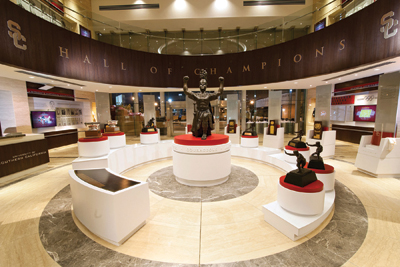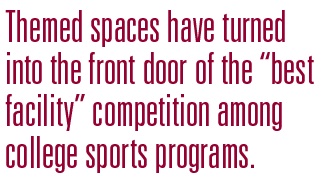While much of the focus in college sports is on gleaming new facilities and major renovations, schools also are going big with opulent interior designs that make bold statements about their programs.
The interior designs, which can cost six figures or more, have become a near requirement for universities that are immersed in the incessant quest for better recruits and more donors and season-ticket holders. The themed spaces, from stadiums and arenas to locker rooms and practice facilities, have turned into the front door of the “best facility” competition that now engrosses college sports.
 |
Southern Cal’s Heritage Hall highlights the school’s championships.
Photo by: USC |
“It’s just become a complete arms race,” said Justin Wood, sports practice director at Kansas City-based Dimensional Innovations. “The facilities themselves have become such an important recruiting tool for student athletes and an important retention tool for donors and fans. … We’ve been doing collegiate athletics work for probably 10 years and doing it very heavily for five years. In those last five years, you can see the growth, movement and sophistication and just the amount of dollars being spent on these facilities.”
The projects typically include modern materials and elements; unique layouts for rooms, corridors and entrance ways; mammoth graphics, signage and collages; special lighting and framing; and, most crucially these days, interactive screens and displays.
Advent CEO John Roberson, whose company has worked on more than 400 collegiate athletic projects, said the trick is to guide perceptions of a given school’s brand in a flashy yet appropriate manner — and do so at a facility that is highly trafficked, such as one that is a stop on a given school’s tour of campus.
“Seventeen- and 18-year-olds who have just gotten off of their newly revised PlayStation 4 or Xbox or a game on their Android or iPhones are exposed to fabulous design; ESPN brings them fabulous graphics and videos. And then you go into a recruiting environment, and it’s almost a bit analog,” Roberson said. “What we’re trying to do is captivate that 17- or 18-year-old, take their focus away from that smartphone and say, ‘For just the next 45 minutes to hour to half of a day, fully engage with us.’”
Firms typically start off such projects by sitting down with school executives to find out what their brand has been
about and how it will be framed moving forward. The results come in the form of projects like that of Marshall University, which created a room at its Hall of Fame specifically dedicated to the 1970 football plane crash that plays such a big part of the school’s history.
At Stanford, the school wanted to highlight its role in developing so-called Stanford Men, and did so in part by creating a huge graphic that lists the attributes of such a man. A specialized iPad loops in clips from the likes of Andrew Luck expounding on the school’s penchant for developing eclectic people.
Meanwhile, UCLA and USC each decided to build elaborate trophy halls at the entrance of facilities at their schools to underscore the national championships they’ve won.
“There’s no question demand has skyrocketed to find ways for collegiate programs to tell their stories,” Mark Jackson, senior associate AD at USC, wrote in an email. “It is so critically important from a fundraising and recruiting perspective to get this right, so when people arrive on campus, there is a wow factor — and they feel part of your story and want to keep coming back.”
Forty Nine Degrees President Michael McClurg, whose company now devotes 95 percent of its time to work in collegiate athletics, said another trend he has spotted recently is a drive to highlight a given school’s apparel deal.
“Gear is a big part of what people are trying to show,” McClurg said. “If you follow a lot of these schools or athletic departments on Twitter, they’re coming out with new uniforms. We’re trying to show that, but via what we do in a facility environment.”
Perhaps the biggest part of the wow-factor push has been the effort to make these spaces interactive. Advent’s Roberson cited internal data as showing that more than half of today’s recruits are posting content on social media from their school tours, underscoring why this has become a priority.
The trend has even reached the conference level. At the Big Ten’s headquarters in Rosemont, Ill., fans visiting the Big Ten Experience can take and share a photo of themselves striking the Heisman pose, or play “Game On!,” an augmented-reality game in which the user either catches a football or blocks a soccer ball or hockey puck. Fans also can hang out at the Big Ten Connect lounge, where they can watch live games and post on social media.
Moreover, many schools have devoted a lot of space to displays that show off video clips and biographies of alumni who have made it to the professional ranks.
For the digital displays, schools often have custom software programs created for them, with built-in ways to update or wholly change the content being displayed as the departments see fit.
For example, screens at USC’s Heritage Hall this past football season displayed different content at each home game that was tailored to things related to the opposing school. Heritage Hall features a museum, athletic offices, sports performance center and locker rooms.
“We’re seeing some of these university locker rooms and team rooms that blow away a lot of what is in the NBA,” said Dimensional Innovations’ Wood. “Coaches want the best that they can possibly have to recruit the best students.”
Adam Stern writes for sister publication SportsBusiness Daily.





